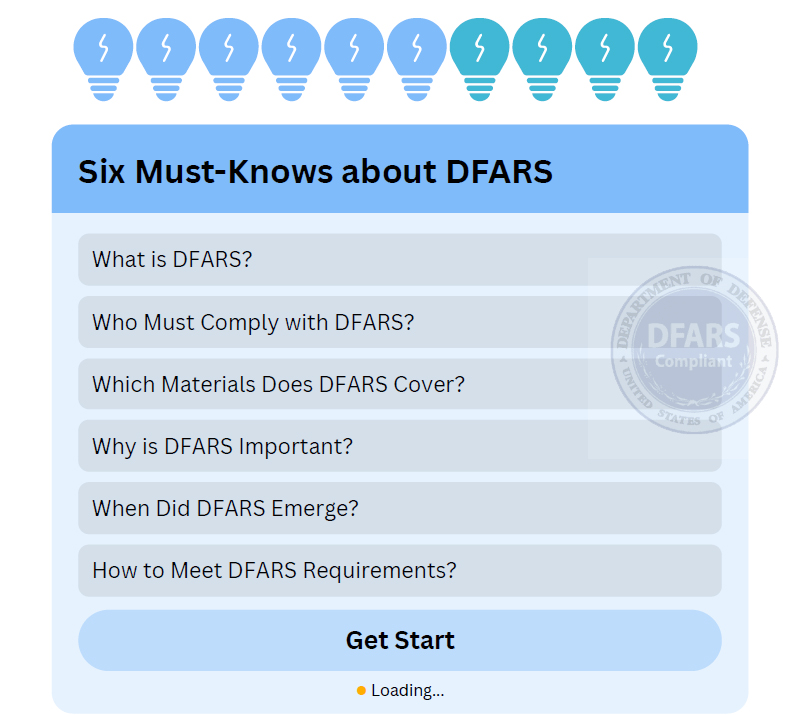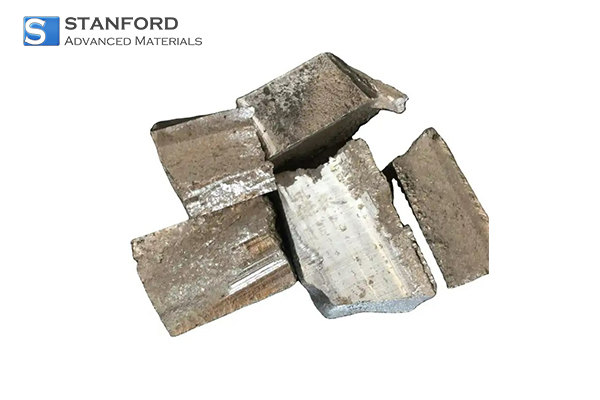Six Must-Knows About DFARS
The Defence Federal Acquisition Regulation Supplement (DFARS) is a fundamental framework used by the US Department of Defence (DoD) to regulate procurement in the defence sector. An understanding of DFARS is essential for all companies that participate in the DoD supply chain. This article provides a structured overview addressing six key questions: What, Who, What, Why, When and How. Further non-Chinese, domestic and DFARS-compliant materials are available at Stanford Advanced Materials.

What is DFARS?
DFARS is a supplement to the Federal Acquisition Regulation (FAR) that is tailored for use by the US Department of Defence. Whereas the FAR applies to all US federal agencies, DFARS introduces additional provisions, clauses and measures to ensure compliance with requirements focused on national defence. These provisions specifically address sensitive information, cyber security and supply chain security.
DFARS adds detailed requirements that cover areas such as:
- Cyber security (e.g. compliance with NIST SP 800-171)
- Controlled Unclassified Information (CUI)
- Supply chain restrictions (e.g. preference for domestic products, procurement excluding China)
- Procurement of special metals, rare earths and electronic components
In effect, DFARS ensures that all goods and services procured by the DoD conform to strict national security, ethical and procurement standards.
Who must comply with DFARS?
Compliance with DFARS is mandatory for all primary contractors and subcontractors working with the Department of Defence. This requirement applies to:
- Prime contractors bidding for or executing defence contracts.
- Sub-suppliers providing components, systems or services used in defence products.
- Third-party service providers that handle sensitive defence data or engage in defence logistics.
Non-US companies operating in the defence sector or entering partnerships may also fall under DFARS if they manage technical data, CUI or cyber security protocols.
Which materials and systems fall under DFARS?
DFARS applies to a broad range of materials, technologies and systems that relate to national security or defence capabilities. Notable categories include:
- Special metals: DFARS 252.225-7009 limits the procurement of titanium, steel, nickel and other metals to sources within the USA or its allied countries.
- Electronic components: Restrictions apply to obtaining semiconductors, microelectronics and optical components from countries such as China.
- IT and cyber systems: Contractors must secure their networks in line with DFARS 252.204-7012 and its associated cyber security clauses.
- Technical data and software: Controlled technical information must be protected according to NIST standards.
- End products: DFARS 252.225-7001 requires certain products to be manufactured either in the USA or in approved allied countries (excluding hostile states).
Why is DFARS important?
DFARS serves several important functions:
- National security: DFARS reduces the risk of espionage and sabotage by preventing unauthorised access to sensitive technologies and defence information.
- Cyber defence: DFARS clauses support the protection of DoD networks and contractor systems from increasingly sophisticated cyber threats.
- Supply chain integrity: DFARS strengthens domestic manufacturing by reducing reliance on foreign sources that may not meet stringent guidelines (for example, suppliers in China).
- Trade regulation compliance: DFARS maintains fair competition under international agreements such as the USMCA, while allowing exceptions for defence matters when necessary.
- Contractor accountability: DFARS requires contractors to provide verifiable compliance through clauses and reporting measures (for example, SPRS and CMMC) rather than relying solely on self-certification.
When were DFARS introduced?
- Origins and development
DFARS were first introduced in 1984 as a supplement to the FAR. Their purpose was to address the specific procurement needs of the Department of Defence, particularly those relating to national security. Since 1984, DFARS have been updated in response to global threats, technological developments and notable cyber security incidents such as the unauthorised access to sensitive defence data including F-35 design files.
- Comparison with FAR
The Federal Acquisition Regulation provides procurement rules for all US federal agencies. In contrast, DFARS are specifically designed for the Department of Defence and contain tailored clauses that address defence-related issues such as cyber security, the protection of technical data and procurement restrictions.
- Comparison with USMCA
The United States-Mexico-Canada Agreement (USMCA) governs trade relations among the three countries. However, DFARS can override USMCA provisions in matters related to national defence. For example, although the USMCA permits the procurement of certain products from Mexico or Canada, DFARS may stipulate that those products are sourced exclusively from US manufacturers or approved allied countries.
How can DFARS requirements be met?
Contractors must take proactive measures to meet DFARS requirements. The steps below detail the process:
1. Understand the relevant clauses
Each defence contract includes applicable DFARS clauses. Contractors should review these clauses carefully and understand their obligations.
2. Implement cyber security controls
For compliance with DFARS 252.204-7012:
- Conduct a gap analysis based on NIST SP 800-171.
- Develop a System Security Plan (SSP) and a Plan of Action and Milestones (POA&M).
- Submit the self-assessment results to SPRS in accordance with DFARS 252.204-7019.
For contracts that require a higher security level, companies may need to obtain a CMMC certification through an accredited third party.
3. Review supply chains
Conduct risk assessments of suppliers to verify that components comply with DFARS procurement requirements (for example, that they are not manufactured in China when restrictions apply). Maintain documented policies that track the origin of materials.
4. Stay informed
DFARS clauses are updated on a regular basis. Subscribe to DoD procurement notifications or consult legal and compliance advisors to ensure that your practices remain current.
5. Training and audits
Train staff on DFARS compliance, particularly personnel in procurement and IT. Prepare for DoD audits and validations under clauses such as DFARS 252.204-7020.
Why choose Stanford Advanced Materials for your DFARS needs?
When complying with DFARS, sourcing from a trustworthy, domestic and non-China-based supply chain is mandatory, especially given the current climate of rising geopolitical risks. In this respect, Stanford Advanced Materials (SAM) is a reliable choice.
SAM supplies a range of DFARS-compliant materials, including special metals, ceramics and rare earths, sourced from manufacturers in the USA or allied countries and not from China or other restricted regions. The company maintains strict traceability of material origins and ensures that all materials meet DFARS procurement clauses.
Conclusion
DFARS is more than a set of regulatory requirements; it is a framework that protects the defence supply chain from cyber threats, unauthorised foreign access and regulatory gaps. Understanding what DFARS is, who it affects, which materials it covers, why it is important, when it was developed and how to comply provides companies with a solid basis for responsible, secure and successful defence contracts.

 Converters & Calculators
Converters & Calculators


 Chin Trento
Chin Trento



